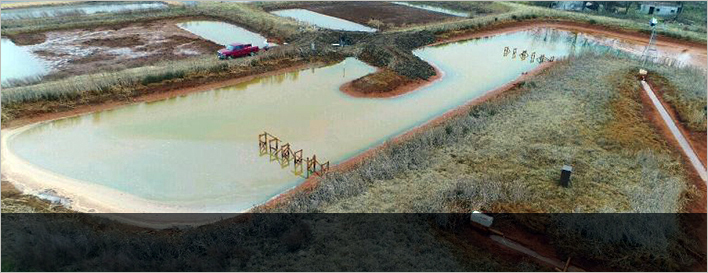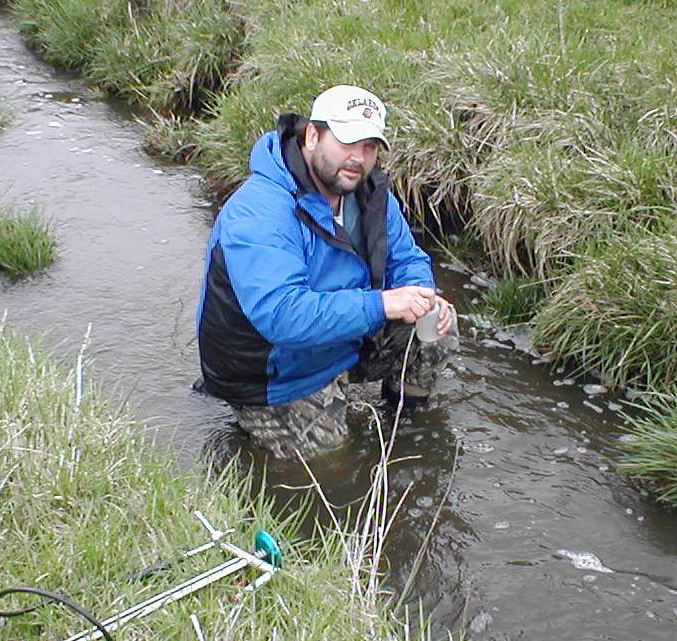Dr. Robert Nairn
Submitted by gina on Thu, 2020-07-16 10:55




EPSCoR Research Focus:
Variable & Marginal Quality Water Supplies 
David L. Boren Professor | Sam K. Viersen Family Foundation Presidential Professor | Director, Center for Restoration of Ecosystems & Watersheds | Assoc. Director, Water Technologies for Emerging Regions Center
School of Civil Engineering & Environmental Science
University of Oklahoma
Spacer:
Please leave this field as it is.
Education:
B.S. | Environmental Science | Juniata College, Huntingdon, PA | 1989
Ph.D. | Environmental Science | Ohio State University, Columbus, OH | 1996
Research Interests:
Dr. Robert Nairn holds both the David L. Boren Professorship and Sam K. Viersen Family Presidential Professorship in the School of Civil Engineering and Environmental Science at the University of Oklahoma, where he also serves as director of the Center for Restoration of Ecosystems & Watersheds (CREW) and associate director of the Water Technologies for Emerging Regions (WaTER) Center. Dr. Nairn is a member of the OK NSF EPSCoR Track-1 RII Award titled Socially Sustainable Solutions for Water, Carbon, and Infrastructure Resilience in Oklahoma. The $20 million research project is a social science-led, multi-disciplinary collaboration among social, physical, biological, engineering, and computational scientists. More than thirty researchers from across the state are working together on the project, which began July 1, 2020.

Dr. Nairn's primary research interests focus broadly on natural infrastructure, especially how functions and services provided by natural and engineered ecosystems provide benefit to the environment and society. Specifically, his research emphasizes watershed- and ecosystem-scale examinations of pollutant transport and fate and applications of ecological engineering, including the designing and building of ecosystems to solve water pollution problems. Dr. Nairn has experience in examining trace metal in mine drainage passive treatment systems; nutrient and related constituent removal from agricultural pollution, urban stormwater, and wastewater in wetlands; documenting receiving stream ecological recovery; as well as general ecosystem restoration and creation, and wetlands science.
Dr. Nairn’s work on the OK NSF EPSCoR project examines the passive treatment of variable and marginal water quality. Treatment wetland mesocosm experiments will be performed to evaluate natural mechanisms (e.g., photolysis, sorption, biodegradation) which address contaminants of emerging concern in municipal wastewater. His research plays a key role in the project's Focus Area 3: Variable and Marginal Quality Water Supplies (V-MQW). The V-MQW Supplies focus area addresses issues surrounding Oklahoma’s water demands, which are projected to increase 600,000 acre-feet per year between 2007-2060. Reliable water supplies are needed to provide for these demands while meeting the state’s goal of capping freshwater use to 2010 levels. However, freshwater supplies are declining due to reservoir sedimentation and groundwater overdraft and are increasingly vulnerable to S2S variability. Concurrently, volumes of oil and gas ‘produced water,’ municipal wastewater, and stormwater are increasing with continued oil and gas development and urbanization. Disposal of produced waters has been correlated with seismicity, potentially impacting infrastructure and resulting in energy production curtailment in some regions. The challenge is finding a mix of solutions that allow Oklahoma’s diverse array of MQW to be economically treated for beneficial use to address water scarcity related to changing seasonal to sub-seasonal weather patterns, waste disposal, and infrastructure risk while supporting continued energy production and economic growth.
--------
Pictured: Dr. Robert Nairn speaking at the Mayer Ranch passive treatment system, Tar Creek Superfund Site, Ottawa County, OK.
Pictured: Dr. Robert Nairn speaking at the Mayer Ranch passive treatment system, Tar Creek Superfund Site, Ottawa County, OK.
Key Publications:
- Shepherd, N.L. and R.W. Nairn. 2020. Metals Retention in a Net Alkaline Mine Drainage Impacted Stream Due to the Colonization of the North American Beaver (Castor canadensis). Science of the Total Environment, doi.org/10.1016/j.scitotenv.2020.139203.
- Arango, J.G. B.K. Holzbauer-Schweitzer, R.W. Nairn and Robert C. Knox. 2020. Generation of Geolocated and Radiometrically Corrected True Reflectance Surfaces in the Visible Portion of the Electromagnetic Spectrum Over Large Bodies of Water using Images from an sUAS. Journal of Unmanned Aerial Systems, doi.org/10.1139/juvs-2019-0020.
- Strosnider, W.H., J. Hugo, N. Shepherd, B.K. Holzbauer-Schweitzer, P. Herve-Fernandez, C. Wolkersdorfer and R.W. Nairn. 2020. A Snapshot of Coal Mine Drainage Discharge Limits for Conductivity, Sulfate and Manganese Across the Developed World. Mine Water and the Environment doi.org/10.1007/s10230-020-00669-8.
- Shepherd, N.L., C.F. Denholm, M.H. Dunn, C.A. Neely, T.P. Danehy and R.W. Nairn. 2020. Biogeochemical Analysis of Spent Media from a 15-Year Old Passive Treatment System Vertical Flow Bioreactor, Mine Water and the Environment 39:68–74, doi.org/10.1007/s10230-020-00652-3.
- Arango, J.G. and R.W. Nairn. 2020. Prediction of Optical and Non-Optical Water Quality Parameters in Oligotrophic and Eutrophic Aquatic Systems Using a Small Unmanned Aerial System. Drones 4(1): 21 pp., doi:10.3390/drones4010001.
- Sun, J., W.H. Strosnider, R.W. Nairn and J.A LaBar. 2020. Water Quality Impacts of In-Stream Mine Tailings on a Headwater Tributary of the Rio Pilcomayo, Potosi, Bolivia. Applied Geochemistry 113 (February 2020), doi.org/10.1016/j.apgeochem.2019.10446.
- Cremeans, M.M., J.F. Devlin, T.C. Osorno and R.W. Nairn. 2019. Assessment of Bed Hydraulics and Metal Loadings in a Passive Vertical Flow Bioreactor in Commerce, Oklahoma. Groundwater Monitoring and Remediation 39(3)40-47.
- Brumley, J.D. and R.W. Nairn. 2018. Litter Decomposition Rates in Six Mine Water Wetlands and Ponds in Oklahoma. Wetlands 38(5): 965-974.
- LaBar, J.A. and R.W. Nairn. 2018. Characterization of trace metal removal products in vertical flow bioreactor substrates at the Mayer Ranch Passive Treatment System in the Tar Creek Superfund Site. Chemosphere 199(2018): 107-113.
- Gu, J., H. He, H. Jin, J. Yu, E. Jeppesen, R.W. Nairn and K. Li. 2018. Synergistic negative effects of small-sized benthivorous fish and nitrogen loading on the growth of submerged macrophytes – relevance for shallow lake restoration. Science of the Total Environment 610/611: 1572-1580.
- Garrido, A.E., W.H. Strosnider, R. Taylor Wilson, J. Condori and R.W. Nairn. 2017. Metal-Contaminated Potato Crops and Potential Human Health Risk in Bolivian Mining Highlands. Environmental Geochemistry and Health. 39(3): 681-700.
- Strosnider, W.H., S.E. Schultz, K.A. Johnson-Strosnider and R.W. Nairn. 2017. Effects on the Underlying Water Column by Extensive Floating Treatment Wetlands. Journal of Environmental Quality. 46(1):201-209.
- Skousen, J., C.E. Zipper, A. Rose, P. Ziemkiewicz, R. Nairn and L.M. McDonald. 2017. Review of Passive Systems for Acid Mine Drainage Treatment. Mine Water and the Environment. 36:133-153.
- LaBar, J.A. and R.W. Nairn. 2016. Evaluating the impacts of Na-SO4 dominated ionic strength on trace metal removal products in vertical flow bioreactors. Applied Geochemistry. 73(2016):24-34.
- Penn, C., J. Bowen, J. McGrath, R. Nairn, G. Fox, G. Brown, S. Wilson and C. Gill. 2016. Evaluation of a universal flow-through model for predicting and designing phosphorus removal structures. Chemosphere. 15: 345-355.
- Peer, R.A., J.A. LaBar, B.K. Winfrey, R.W. Nairn, F.S. Llanos Lopez and W.H. Strosnider. 2015. Removal of Less Commonly Addressed Metals via Passive Co-Treatment. Journal of Environmental Quality. 44(2): 704-710.
- Strosnider, W.H.J., B.K. Winfrey, R.A.M. Peer and R.W. Nairn. 2013. Passive Co-Treatment of Acid Mine Drainage and Sewage: Anaerobic Incubation Reveals a Regeneration Technique and Further Treatment Possibilities. Ecological Engineering. 61: 268-273.
Related Links:
Latest News
Wednesday, July 02, 2025
Monday, June 30, 2025
Monday, June 02, 2025
Upcoming Events
Monday, April 27, 2026 - 8:00am - Tuesday, April 28, 2026 - 12:00pm
Wednesday, September 23, 2026 - 9:00am - 5:00pm
